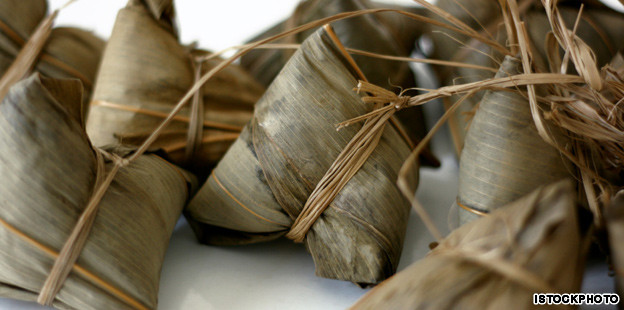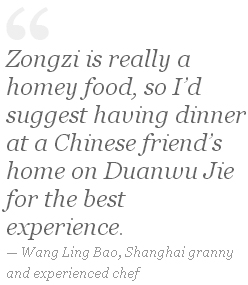Posted on 15 June, 2010
 Zongzi. Photo by Flickr user avlxyz
Zongzi. Photo by Flickr user avlxyz
If there was an award for most underrated Chinese “dumpling”, it would go to the zongzi (粽子). Traditionally eaten on the day of the Dragon Boat Festival (Duanwu Jie, 端午节), zongzi are pyramidal, bamboo-wrapped packets of steamed glutinous rice with sweet or savory filling.
Zongzi have been around since the Warring States period. In typical Chinese fashion, the legend surrounding the invention of zongzi is colorful and varied. But the most commonly told story involves the waterlogged corpse (and persistent ghost) of a Zhou Dynasty poet and high official, man-eating fish and the efforts of kind local people who threw bamboo-wrapped rice packets (zongzi) into the Miluo river to keep the two separated.
Zongzi for all appetites
Despite their spooky origins and geometric shape, zongzi is a must-try seasonal treat. In Shanghai, you’ll find the most variety of zongzi in June, from the minimalistic local zongzi to the pork-plus-more Cantonese and Taiwanese varieties or the petite Japanese chimaki.
With selections of zongzi popping up everywhere, how do you tell a dud from a winner?
According to Chef Tang Chi Keung of The Peninsula Hotel's highly buzzed about Yi Long Court restaurant, it’s principally the wrapping and the fat to lean meat ratio in the filling that separates the delicious zongzi from the so-so.
Pork power
“Pork must be in the filling. And it has to be half lean pork and half fatty pork. If they put in too much of either, the flavor balance is off,” stresses Chef Tang who also uses lotus seeds, split mung beans, shiitake mushroom, roast duck, pork, conpoy and salted duck egg yolk to create the filling of his gargantuan zongzi, which weigh a pound each and take 10 hours to boil.
The expertise of the zongzi maker also shows in the wrapping, so feel for the firmness of zongzi before you buy them, suggests Tang. “A well-made zongzi should be tightly wrapped in the bamboo leaves and twine”
Shanghai zongzi or Jiaxing zongzi?

Shanghai granny and home chef Wang Ling Bao doesn’t have a Michelin star, but she can boast that she's never had a single zongzi come undone during 30+ years of making them for her kids and grand kids. According to her, the best Shanghai zongzi are actually from a nearby town called Jiaxing (嘉兴) and many locals still make the 45-minute trek by car to pick up them up for the holiday.
“Shanghainese have adapted the flavor of Jiaxing zongzi,” she says, as she tucks two pieces of braised pork into a cone of bamboo leaves. Unlike the elaborate of ingredients used in Cantonese zongzi, Jiaxing-style zongzi have quite simple fillings: savory soy braised fatty pork or sweet red bean.
As for where you can get the best zongzi in town, Wang says: “Wu Fang Zhai is famous for their Jiaxing-style zongzi. Restaurant Xiao Nan Guo’s zongzi are also good. But I think zongzi is really a homey food, so I’d suggest having dinner at a Chinese friend’s home on Duanwu Jie for the best experience.”
Wang Ling Bao’s Zongzi

Ingredients:
About 22 large bamboo leaves, soaked in hot water for four hours until pliable Uncolored string (cut into 8 inch pieces)
2 pounds of glutinous rice (aka sticky rice)
3.5 pounds of fatty pork (pork butt or pork belly work well)
1 cup of light soy sauce
1 large handful of scallions
2 tablespoons of sugar, to taste
Shaoxing rice wine, to taste
Method:
For the filling, dice your fatty pork into roughly 1 inch cubes and marinate for two hours in a half cup of soy sauce plus scallions. Meanwhile, rinse your uncooked glutinous rice, add soy sauce to taste.
Cut the strings for tying the zongzi.
In a wok, add oil and brown your pork, adding more soy sauce, Shaoxing rice wine and sugar to taste.
Put the cooked meat in a bowl and let cool. Reserve the liquid and mix in with the rice.
Make sure there are no holes in any of your bamboo leaves. Grab one bamboo leaf, and cut off its stem. Make a cone using the bottom of the leaf. Make sure the tip of the cone is sealed. Add a few spoonfuls of rice. When you get to the center of your zongzi, add two or three chunks of meat. Use a single chopstick to get the rice into the corners of the zongzi. Using a spoon, spoon more rice over the pork into the cone until it is almost full. Leave a 5cm gap unfilled so the rice will have room to expand.
Fold the remaining part of the leaf over the top of the cone and wrap the rest tightly around the zongzi. Then tie a piece of string all around the zongzi.
Boil for about 40 minutes and enjoy.
